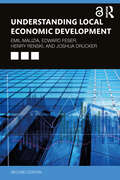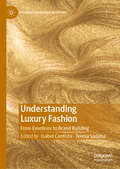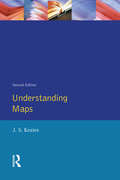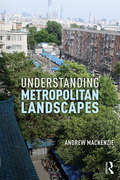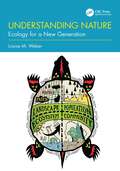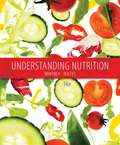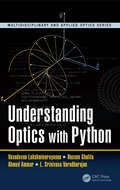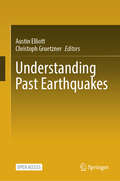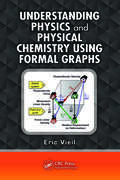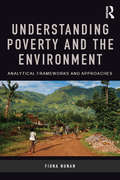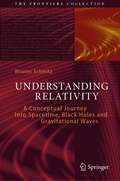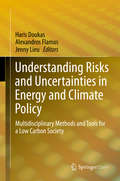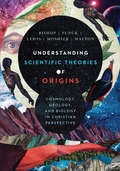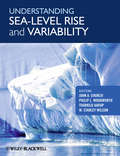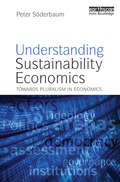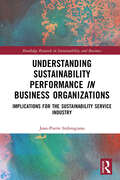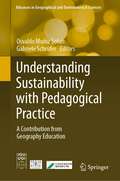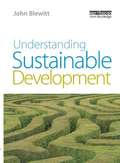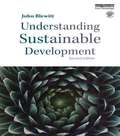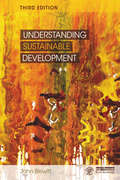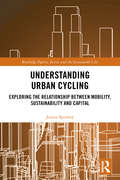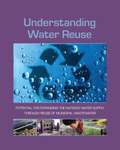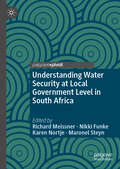- Table View
- List View
Understanding Local Economic Development: Second Edition
by Emil Malizia Henry Renski Edward J. Feser Joshua DruckerThis book offers insights into the process and the practice of local economic development. Bridging the gap between theory and practice, it demonstrates the relevance of theory to inform local strategic planning in the context of widespread disparities in regional economic performance. The book summarizes the core theories of economic development, applies each theory to professional practice, and provides detailed commentary on them. This updated second edition includes more recent contributions—regional innovation, agglomeration, and dynamic theories—and presents the major ideas that inform economic development strategic planning, particularly in the United States and Canada. The text offers theoretical insights that help explain why some regions thrive while others languish and why metropolitan economies often rise and fall over time. Without theory, economic developers can only do what is politically feasible. This book, however, provides them with a logical tool for thinking about development and establishing an independent basis on which the local consensus needed for evidence-based action undertaken in the public interest can be built. Offering valuable perspectives on both the process and the practice of local and regional economic development, this book will be useful for both current and future economic developers to think more profoundly and confidently about their local economy.
Understanding Local Economic Development: Second Edition
by Emil Malizia Henry Renski Edward J. Feser Joshua DruckerThis book offers insights into the process and the practice of local economic development. Bridging the gap between theory and practice it demonstrates the relevance of theory to inform local strategic planning in the context of widespread disparities in regional economic performance.The book summarizes the core theories of economic development, applies each of these to professional practice, and provides detailed commentary on them. This updated second edition includes more recent contributions - regional innovation, agglomeration and dynamic theories – and presents the major ideas that inform economic development strategic planning, particularly in the United States and Canada. The text offers theoretical insights that help explain why some regions thrive while others languish and why metropolitan economies often rise and fall over time. Without theory, economic developers can only do what is politically feasible. This text, however, provides them with a logical tool for thinking about development and establishing an independent basis from which to build the local consensus needed for evidence-based action undertaken in the public interest.Offering valuable perspectives on both the process and the practice of local and regional economic development, this book will be useful for both current and future economic developers to think more profoundly and confidently about their local economy.The Open Access version of this book, available at http://www.taylorfrancis.com, has been made available under a Creative Commons Attribution-Non Commercial-No Derivatives (CC-BY-NC-ND) 4.0 license.
Understanding Luxury Fashion: From Emotions to Brand Building (Palgrave Advances in Luxury)
by Teresa Sádaba Isabel CantistaOffering an original contribution to the field of luxury and fashion studies, this edited collection takes a philosophical perspective, addressing the idea that humans need luxury. From this framework it delves deep into two particular dimensions of luxury, emotions and society, and concludes with cases of brand building in order to illustrate the two dimensions at work. Comparative analysis between countries is brought together with an emphasis on China. Chapters address the ongoing growth in the market, as well as the significant changes in the sector brought about by fast international expansion and an increased focus on ethical supply and sustainability, making the book an insightful read for scholars of fashion business, luxury and branding.
Understanding Maps
by J. S. KeatesAddresses the fundamental principles of visual perception and map symbolism and critically examines the assumptions behind the theories of psychophysical testing and cartographic communication. This revised and expanded edition includes new sections on the relationship between cartography and art, and the distinction between knowledge and skill.
Understanding Mathematical Concepts in Physics: Insights from Geometrical and Numerical Approaches (Lecture Notes in Physics #1030)
by Sanjeev DhurandharModern mathematics has become an essential part of today’s physicist’s arsenal and this book covers several relevant such topics. The primary aim of this book is to present key mathematical concepts in an intuitive way with the help of geometrical and numerical methods - understanding is the key. Not all differential equations can be solved with standard techniques. Examples illustrate how geometrical insights and numerical methods are useful in understanding differential equations in general but are indispensable when extracting relevant information from equations that do not yield to standard methods. Adopting a numerical approach to complex analysis it is shown that Cauchy’s theorem, the Cauchy integral formula, the residue theorem, etc. can be verified by performing hands-on computations with Python codes. Figures elucidate the concept of poles and essential singularities. Further the book covers topology, Hilbert spaces, Fourier transforms (discussing how fast Fourier transform works), modern differential geometry, Lie groups and Lie algebras, probability and useful probability distributions, and statistical detection of signals. Novel features include: (i) Topology is introduced via the notion of continuity on the real line which then naturally leads to topological spaces. (ii) Data analysis in a differential geometric framework and a general description of χ2 discriminators in terms of vector bundles. This book is targeted at physics graduate students and at theoretical (and possibly experimental) physicists. Apart from research students, this book is also useful to active physicists in their research and teaching.
Understanding Metropolitan Landscapes
by Andrew MacKenzieUnderstanding Metropolitan Landscapes considers and reflects on the fundamental relationships between metropolitan regions and their landscapes. It investigates how planning and policy help to protect, manage and enhance the landscapes that sustain our urban settlements. As global populations become more metropolitan, landscapes evolve to become increasingly dynamic and entropic; and the distinction between urban and non-urban is further fragmented and yet these spaces play an increasingly important role in sustainable development. This book opens a key critical discussion into the relational aspects of city and landscape and how each element shapes the boundaries of the other, covering topics such as material natures, governance systems, processes and policy. It presents a compendium of concepts and ideas that have emerged from landscape architecture, planning, and environmental policy and landscape management. Using a range of illustrated case studies, it provokes discussions on the major themes driving the growth of cities by exploring the underlying tensions around notions of sustainable settlement, climate change adaption, urban migration, new modes of governance and the role of landscape in policy and decision making at national, provincial and municipal levels.
Understanding Nature: Ecology for a New Generation
by Louise M. WeberUnderstanding Nature is a new kind of ecology textbook: a straightforward resource that teaches natural history and ecological content, and a way to instruct students that will nurture both Earth and self. While meeting the textbook guidelines set forth by the Ecological Society of America, Understanding Nature has a unique ecotherapy theme, using a historical framework to teach ecological theory to undergraduates. This textbook presents all the core information without being unnecessarily wordy or lengthy, using simple, relatable language and discussing ecology in ways that any student can apply in real life. Uniquely, it is also a manual on how to improve one’s relationship with the Earth. This is accomplished through coverage of natural history, ecology, and applications, together with suggested field activities that start each chapter and thinking questions that end each chapter. The book includes traditional ecological knowledge as well as the history of scientific ecological knowledge. Understanding Nature teaches theory and applications that will heal the Earth. It also teaches long-term sustainability practices for one’s psyche. Professor Louise Weber is both an ecologist and a certified ecopsychologist, challenging ecology instructors to rethink what and how they teach about nature. Her book bridges the gap between students taking ecology to become ecologists and those taking ecology as a requirement, who will use the knowledge to become informed citizens.
Understanding Nutrition: Fourteenth Edition
by Ellie Whitney Sharon Rady RolfesMore than one million readers make UNDERSTANDING NUTRITION the best-selling introductory nutrition book on the market today! Now in its 14th Edition, this book maintains the quality and support that discerning readers demand in nutrition applications and science that are ideal at introductory levels. New and updated topics refresh every chapter, along with the emphasis on active learning, assignable content, and integrated resources that help you advance your knowledge and career. Connecting with you through an approachable writing style, UNDERSTANDING NUTRITION, 14th Edition includes twenty chapters on topics such as diet planning, macronutrients, vitamins and minerals, diet and health, fitness, life span nutrition, food safety, and world hunger, among others. Combined with a carefully developed art program and a variety of interactive activities, UNDERSTANDING NUTRITION, 14th Edition continues to set the standard for introductory nutrition texts.
Understanding Optics with Python (Multidisciplinary and Applied Optics)
by Ahmed Ammar Vasudevan Lakshminarayanan Hassen Ghalila L. VaradharajanOptics is an enabling science that forms a basis for our technological civilization. Courses in optics are a required part of the engineering or physics undergraduate curriculum in many universities worldwide. The aim of Understanding Optics with Python is twofold: first, to describe certain basic ideas of classical physical and geometric optics; second, to introduce the reader to computer simulations of physical phenomena. The text is aimed more broadly for those who wish to use numerical/computational modeling as an educational tool that promotes interactive teaching (and learning). In addition, it offers an alternative to developing countries where the necessary equipment to carry out the appropriate experiments is not available as a result of financial constraints. This approach contributes to a better diffusion of knowledge about optics. The examples given in this book are comparable to those found in standard textbooks on optics and are suitable for self-study. This text enables the user to study and understand optics using hands-on simulations with Python. Python is our programming language of choice because of its open-source availability, extensive functionality, and an enormous online support. Essentials of programming in Python 3.x, including graphical user interface, are also provided. The codes in the book are available for download on the book’s website. Discusses most standard topics of traditional physical and geometrical optics through Python and PyQt5 Provides visualizations and in-depth descriptions of Python’s programming language and simulations Includes simulated laboratories where students are provided a "hands-on" exploration of Python software Coding and programming featured within the text are available for download on the book’s corresponding website. "Understanding Optics with Python by Vasudevan Lakshminarayanan, Hassen Ghalila, Ahmed Ammar, and L. Srinivasa Varadharajan is born around a nice idea: using simulations to provide the students with a powerful tool to understand and master optical phenomena. The choice of the Python language is perfectly matched with the overall goal of the book, as the Python language provides a completely free and easy-to-learn platform with huge cross-platform compatibility, where the reader of the book can conduct his or her own numerical experiments to learn faster and better."— Costantino De Angelis, University of Brescia, Italy "Teaching an important programming language like Python through concrete examples from optics is a natural and, in my view, very effective approach. I believe that this book will be used by students and appreciated greatly by instructors. The topic of modelling optical effects and systems where the students should already have a physical background provides great motivation for students to learn the basics of a powerful programming language without the intimidation factor that often goes with a formal computer science course." — John Dudley, FEMTO-ST Institute, Besançon, France
Understanding Past Earthquakes
by Austin Elliott Christoph GruetznerThis open access book presents the state of the art in research on the characteristics of past earthquakes. It presents an overview of contemporary developments, their use cases, and practical considerations, with the aim of introducing readers to recently developed methodologies as well as the sources, derivation, and handling of their uncertainties. The disparate fields of seismology, stratigraphy, geomorphology, and geodesy are all being applied to the common goal of understanding past earthquakes, and in this realm, each has experienced significant advances in the 2010s. The contents cover contemporary methods in remote sensing geomorphology, forensic pre-instrumental seismology, historic macroseismology, and paleogeodesy, some of which are already being employed together to derive a holistic picture of seismic events past. This book compiles in one resource the respective explanations of the diverse array of tools which are being used in the 2020s to investigate past seismic events to expand our seismic record.
Understanding Physics and Physical Chemistry Using Formal Graphs
by Eric VieilThe subject of this book is truly original. By encoding of algebraic equations into graphs-originally a purely pedagogical technique-the exploration of physics and physical chemistry reveals common pictures through all disciplines. The hidden structure of the scientific formalism that appears is a source of astonishment and provides efficient simpl
Understanding Poverty and the Environment: Analytical frameworks and approaches
by Fiona NunanDoes poverty lead to environmental degradation? Do degraded environments and natural resources lead to poverty? Or, are there other forces at play? Is the relationship between poverty and the environment really as straightforward as the vicious circle portrayal of ‘poverty leading to environmental destruction leading to more poverty’ would suggest? Does it matter if the relationship is portrayed in this way? This book suggests that it does matter. Arguing that such a portrayal is unhelpful and misleading, the book brings together a diverse range of analytical frameworks and approaches that can enable a much deeper investigation of the context and nature of poverty-environment relationships. Analytical frameworks and approaches examined in the book include political ecology, a gendered lens, Critical Institutionalism, the Environmental Entitlements framework, the Institutional Analysis and Development approach, the Sustainable Livelihoods Framework, wellbeing analysis, social network analysis and frameworks for the analysis of the governance of natural resources. Recommended further reading draws on published material from the last thirty years as well as key contemporary publications, giving readers a steer towards essential texts and authors within each subject area. Key themes running through the analytical frameworks and approaches are identified and examined, including power, access, institutions and scale.
Understanding Relativity: A Conceptual Journey Into Spacetime, Black Holes and Gravitational Waves (The Frontiers Collection)
by Wouter SchmitzThis book bridges the huge gap between popular science and mathematical treatments of Einstein's theories. It explains special and general relativity, gravity, black holes, and gravitational waves, also presenting current ideas about dark matter and dark energy. The explanations are entirely non-mathematical, using many color pictures and clear concepts. In this way, the reader is led to a much deeper understanding than any popular science book can provide. The author has written this book for everyone who wants to go beyond superficial descriptions of relativity's remarkable phenomena, but is not equipped to read the professional literature and complicated math behind the theory. By providing a complete description in terms of concepts and pictures, the book answers many questions about why the theory works as it does. For example, it explains why and how momentum and pressure are related to gravity; why and how mass causes spacetime to curve and how curvature tells objects how to move; it also reveals the origin of the ring seen around the first ever image of a black hole. Not least, the reader will learn in detail how gravitational waves are produced and measured. Since their conception, the theories of relativity have appealed to the public's imagination. Thanks to this book, readers now have the opportunity to convert their fascination with the topic to a deep understanding.
Understanding Risks and Uncertainties in Energy and Climate Policy: Multidisciplinary Methods And Tools For A Low Carbon Society
by Haris Doukas Alexandros Flamos Jenny LieuThis open access book analyzes and seeks to consolidate the use of robust quantitative tools and qualitative methods for the design and assessment of energy and climate policies. In particular, it examines energy and climate policy performance and associated risks, as well as public acceptance and portfolio analysis in climate policy, and presents methods for evaluating the costs and benefits of flexible policy implementation as well as new framings for business and market actors. In turn, it discusses the development of alternative policy pathways and the identification of optimal switching points, drawing on concrete examples to do so. Lastly, it discusses climate change mitigation policies’ implications for the agricultural, food, building, transportation, service and manufacturing sectors.
Understanding Scientific Theories of Origins: Cosmology, Geology, and Biology in Christian Perspective (BioLogos Books on Science and Christianity)
by John H. Walton Robert C. Bishop Larry L. Funck Stephen O. Moshier Raymond J. LewisThe question of origins remains a stumbling block for many. But just as the Psalmist gained insight into God's character through the observation of nature, modern scientific study can deepen and enrich our vision of the Creator and our place in his creation. In this often contentious field Bishop, Funck, Lewis, Moshier, and Walton serve as our able guides. Based on over two decades of teaching origins together in the classroom, the authors present a textbook exploring mainstream scientific theories of origins in astronomy, cosmology, chemistry, geology, biology, physical anthropology, and genetics. While many authors engage origins from a Christian perspective, this is the first work offering a full-fledged discussion of the scientific narrative of origins from the Big Bang through humankind, from biblical and theological perspectives accessible to a lay audience. Topics include Principles of biblical interpretation Close readings of relevant Genesis texts A comprehensive Trinitarian doctrine of creation Cosmic origins The geologic history of Earth The origin of life on Earth The origin of species and diversity of life Human origins New creation and creation care Science education Rather than the familiar scenario where science and faith compete, this book seeks to diffuse tensions by taking the inspiration and authority of the Bible seriously while respecting and honoring God's revelation through creation. Understanding Scientific Theories of Origins gives the reader a detailed picture of the sciences of origins along with how they fit into the story of God's creative and redemptive action.
Understanding Sea-level Rise and Variability
by Thorkild Aarup Philip L. Woodworth W. Stanley Wilson John A. ChurchUnderstanding Sea-Level Rise and Variability identifies the major impacts of sea-level rise, presents up-to-date assessments of past sea-level change, thoroughly explores all of the factors contributing to sea-level rise, and explores how sea-level extreme events might change. It identifies what is known in each area and what research and observations are required to reduce the uncertainties in our understanding of sea-level rise so that more reliable future projections can be made. A synthesis of findings provides a concise summary of past, present and future sea-level rise and its impacts on society.Key Features:Book includes contributions from a range of international sea level experts Multidisciplinary Four color throughout Describes the limits of our understanding of this crucial issue as well as pointing to directions for future research The book is for everyone interested in sea-level rise and its impacts, including policy makers, research funders, scientists, students, coastal managers and engineers.Additional resources for this book can be found at: http://www.wiley.com/go/church/sealevel.
Understanding Sustainability Economics: Towards Pluralism in Economics
by Peter SoderbaumThis highly readable yet challenging book provides a critical examination of the failings of mainstream economics and the resultant environmental problems we are facing. Most importantly, it articulates what an alternative economics for sustainability would look like in both theory and practice. The book provides a brief history of economics and looks at the intersection between politics and the often hidden values embedded in economics. Also covered are the roles of individuals and organizations, political structures and institutions, democracy, environmental decision-making, sustainability assessment and a vision of a future underpinned by sustainability economics. A main point raised is that, in any serious attempt to come to grips with unsustainable trends, fundamental issues such as the theory of science, the role of science in society, paradigms in economics, ideological orientations and institutional arrangements need to be critically examined. The theory is supported by case studies, explanatory figures, further reading sections and discussion questions to facilitate debate and learning.
Understanding Sustainability Performance in Business Organizations: Implications for the Sustainability Service Industry (Routledge Research in Sustainability and Business)
by Jean-Pierre ImbrogianoThis book sheds new light on the role businesses can play in contributing to sustainability objectives, and how governance actors can better encourage their contributions. Jean-Pierre Imbrogiano introduces and empirically investigates the concept of sustainability performance in businesses, which reveals how achieving social and environmental objectives is experienced within business organizations. He focuses on supply chain management as a key part in this process and looks at how this has evolved to become a vital sector in the global business landscape. He further considers the current practices of governance actors which aim to enable sustainability performance in businesses. Labelled as a ‘sustainability service industry’, these actors include international, national, and industry sustainability initiatives, sustainability standard setters, business consultancies and rating agencies, as well as sustainable supply chain managers in corporations. Overall, this book calls for a conceptual reorientation in business sustainability scholarship, and points towards a challenging agenda for change in the sustainability service industry. Understanding Sustainability Performance in Business Organizations will be of great interest to students and scholars of sustainable business, business ethics, corporate social responsibility, sustainable supply chain management, and sustainability governance.
Understanding Sustainability with Pedagogical Practice: A Contribution from Geography Education (Advances in Geographical and Environmental Sciences)
by Osvaldo Muñiz Solari Gabriele SchrüferThis book shares with an international audience of teachers, scholars, and policymakers the experience of pedagogical practices to facilitate sustainability in the world. Sustainability is seen here as a journey toward the end state of sustainable development. Therefore, the authors contribute different roads to engage teachers and students with pedagogical discourse. Overall, the book demonstrates the value of powerful knowledge through action-oriented learning based on a bottom-up process. Consequently, pedagogical practices are understood as the instructional approaches based on a social constructivist model in which active learning is performed with student-to-student engagement. Secondary teachers in social sciences and university professors in geography find the study to be a valuable source of stimulation for incorporating new ideas and resolving common problems in their learning and teaching environments. Education policymakers around the world also benefit from the only publication that presents international perspectives on geographical knowledge related to sustainability.The contributing authors are experienced scientists in the field of geography education who are giving special attention to pedagogical practices that promote new directions toward sustainable thinking.This book is the first outcome of an international collaboration officially established in 2023 between the Department of Geography and Environmental Studies at Texas State University and the Department of Geography at the University of Bayreuth.
Understanding Sustainable Development
by John BlewittThis book demonstrates why sustainable development that celebrates complexity and diversity is such a necessity effectively with empirical case studies and thinking questions.
Understanding Sustainable Development
by John BlewittThis new and expanded edition builds upon the first edition's powerful multi-perspective approach and breath of coverage. A truly comprehensive introduction to sustainable development, it is designed specifically to allow access to the topic from a wide range of educational and professional backgrounds and to develop understanding of a diversity of approaches and traditions at different levels. This second edition includes: a complete update of the text, with increased coverage of major topics including ecosystems; production and consumption; business; urban sustainability; governance; new media technologies; conservation; leadership; globalization and global crises; sustainability literacy and learning; more examples from the Global South and North America, while retaining its unique coverage of first world countries; chapter aims at the start and summaries at the end of each chapter; glossary of key terms; a new chapter on Conservation with a focus on behaviour change and values; a brand new website which includes discussion of how projects are done on the ground, additional exercises and online cases, test questions and recommended readings and films. Offering boxed examples from the local to the global, Understanding Sustainable Development is the most complete guide to the subject for course leaders, undergraduates and postgraduates.
Understanding Sustainable Development
by John BlewittA truly comprehensive introduction to the topic, Understanding Sustainable Development is designed to give students on a wide range of courses an appreciation of the key concepts and theories of sustainable development. Fully updated, the third edition includes detailed coverage of the Sustainable Development Goals and their impact on global development. Major challenges and topics are explored through a range of international case studies and media examples which maintain the ‘global to local’ structure of the previous edition. With an extensive website and pedagogy, Understanding Sustainable Development is the most complete guide to the subject for course leaders, undergraduates and postgraduates.
Understanding Urban Cycling: Exploring the Relationship Between Mobility, Sustainability and Capital (Routledge Equity, Justice and the Sustainable City series)
by Justin SpinneyAcademic interest in cycling has burgeoned in recent years with significant literature relating to the health and environmental benefits of cycling, the necessity for cycle-specific infrastructure, and the embodied experiences of cycling. Based upon primary research in a variety of contexts such as London, Shanghai and Taipei, this book demonstrates that recent developments in urban cycling policy and practice are closely linked to broader processes of capital accumulation. It argues that cycling is increasingly caught up in discourses around Smart cities that emphasise technological solutions to environmental problems and neoliberal ideas on individual responsibility and biopolitical conduct, which only results in solutions that prioritise those who are already mobile. The central argument of the book is not that the popularisation of cycling is inherently bad, but that the manner in which cycling is being popularised gives cause for social and environmental concern. Ultimately the book argues that cycling has now become a vehicle for sustaining pro-growth agendas rather than subverting them or shifting to sustainable no-growth/de-growth and less technologically driven visions of modernity. This book makes an innovative contribution to the fields of Cycling Studies, Mobilities and Transport and will be of interest to students and academics working in Human Geography, Transport Studies, Urban Studies, Urban Planning, Public Policy, Sociology and Sustainability.
Understanding Water Reuse
by National Research Council Water Science and Technology Board Division on Earth and Life Studies Committee on the Assessment of Water Reuse as an Approach to Meeting Future Water Supply NeedsIn communities all around the world, water supplies are coming under increasing pressure as population growth, climate change, pollution, and changes in land use affect water quantity and quality. To address existing and anticipated water shortages, many communities are working to increase water conservation and are seeking alternative sources of water. Water reuse- the sue of treated wastewater, or "reclaimed" water, for beneficial purposes such as drinking, irrigation, or industrial uses- is one option that has helped some communities significantly expand their water supplies. Understanding Water Reuse summarizes the main findings of the National Research Council report Water Reuse: Expanding the Nation's Water Supply Through Reuse of Municipal Wastewater. The report provides an overview of the options and outlook for water reuse in the United States, discusses water treatment technologies and potential uses of reclaimed water, and presents a new analysis that compares the risks of drinking reclaimed water to those of drinking water from traditional sources.
Understanding Water Security at Local Government Level in South Africa
by Richard Meissner Nikki Funke Karen Nortje Maronel SteynThis book provides unique insights into the complex issue of water security in South Africa. Based on qualitative research conducted through face-to-face structured interviews and focus group discussions with individuals, traditional leaders, municipal officials, researchers, businesspeople and farmers in the two local governments – the Sekhukhune District and eThekwini Metropolitan Municipalities – it focuses on the peoples’ understanding of the concept of water security and whether they believe that the municipalities have achieved water security for all. The research is supported by water security-related statistics, particularly those pertaining to water quality and quantity, and an extensive literature review for the concept of water security. In addition to assessing the state of water security in both municipalities, the book presents a new water security definition and typology, and offers valuable recommendations for future research.
